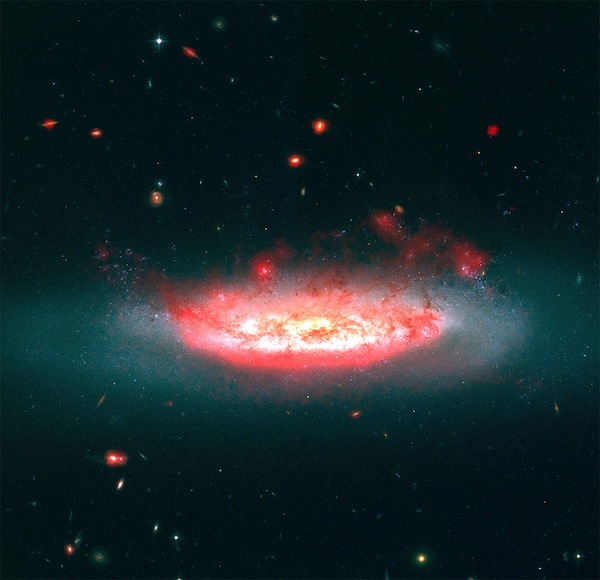The Answer is Blowing in the Intergalactic Wind

Image credit: Suresh Sivanandam; Dunlap Institute for Astronomy & Astrophysics
Astronomers have theorized that as a field galaxy falls into a cluster of galaxies, it encounters the cloud of hot gas at the centre of the cluster. As the galaxy moves through this intra-cluster medium at thousands of kilometres per second, the cloud acts like a wind, blowing away the gas within the galaxy without disturbing its stars. The process is known as ram-pressure stripping.
Previously, astronomers had seen the very tenuous atomic hydrogen gas surrounding a galaxy get stripped. But it was believed that the denser molecular hydrogen clouds where stars form would be more resistant to the wind. “However, we found that the molecular hydrogen gas is also blown from the in-falling galaxy,” says Suresh Sivanandam of the Dunlap Institute at the University of Toronto, “much like smoke blown from a candle being carried into a room.”
Previous observations showed indirect evidence of ram-pressure stripping of star-forming gas. Astronomers have observed young stars trailing from a galaxy; the stars would have formed from gas newly-stripped from the galaxy. A few galaxies also have tails of very tenuous gas. But the latest observations show the stripped, molecular hydrogen itself, which can be seen as a wake trailing from the galaxy in the direction opposite to its motion.
“For more than 40 years we have been trying to understand why galaxies in dense clusters have so few young stars compared with ones like our Milky Way Galaxy, but now we see the quenching of star formation in action,” says George Rieke of the University of Arizona. “Cutting off the gas that forms stars is a key step in the evolution of galaxies from the early Universe to the present.”
The results, published in the Astrophysical Journal on Nov. 10, are from observations of four galaxies. Sivanandam, Rieke and colleague Marcia Rieke (also from the University of Arizona) had already established that one of the four galaxies had been stripped of its star-forming gas by this wind. But by observing four galaxies, they have now shown that this effect is common.
The team made their analysis using optical, infrared and hydrogen-emission data from the Spitzer and Hubble space telescopes, as well as archival ground-based data. The team used an infrared spectrograph on the Spitzer because direct observation of the molecular hydrogen required observations in the mid-infrared part of the spectrum—something that’s almost impossible to do from the ground.
“Seeing this stripped molecular gas is like seeing a theory on display in the sky,” says Marcia Rieke. “Astronomers have assumed that something stopped the star formation in these galaxies, but it is very satisfying to see the actual cause.”
-30-
See the paper:
http://iopscience.iop.org/0004-637X/796/2/89/
Image information:
A composite image shows the galaxy NGC 4522 in the Virgo Cluster, the nearest large cluster of galaxies to our own local group of galaxies, and the “wake” of gas and dust being blown from the galaxy. The galaxy appears blue in the Hubble Space Telescope image in visible light. The superimposed red image is from Spitzer data and shows emissions from dust that traces molecular hydrogen. In the image, the galaxy is moving down and into the plane of the photo. (For a large version of the image, click on the image on the right.)
Image credit: Suresh Sivanandam; Dunlap Institute for Astronomy & Astrophysics
Contact information
Dr. Suresh Sivanandam
Dunlap Institute for Astronomy & Astrophysics
University of Toronto
p: 416-978-2183
e: sivanandam@dunlap.utoronto.ca
Professor George Rieke
Steward Observatory
University of Arizona
e: grieke@as.arizona.edu
Professor Marcia Rieke
Steward Observatory
University of Arizona
e: mrieke@as.arizona.edu
Chris Sasaki
Communications Coordinator
Dunlap Institute for Astronomy & Astrophysics
University of Toronto
p: 416-978-6613
e: csasaki@dunlap.utoronto.ca
Daniel Stolte
Office of University Relations, Communications
University of Arizona
p: 520-626-4402
e: stolte@email.arizona.edu
The Dunlap Institute for Astronomy & Astrophysics, University of Toronto, continues the legacy of the David Dunlap Observatory by developing innovative astronomical instrumentation, including for the largest, most advanced telescopes in the world; by training the next generation of astronomers; and by fostering public engagement in science. The research of its faculty and postdoctoral fellows includes the discovery and characterization of exoplanets, the formation of stars, galactic nuclei, the evolution and nature of galaxies, the early Universe and Large Scale Structure, and the Search for Extra-terrestrial Intelligence (SETI). Together, the Dunlap Institute, the University of Toronto’s Department of Astronomy & Astrophysics, and the Canadian Institute for Theoretical Astrophysics comprise the leading centre for astronomical research in Canada at the country’s leading research university.
Media Contact
All latest news from the category: Physics and Astronomy
This area deals with the fundamental laws and building blocks of nature and how they interact, the properties and the behavior of matter, and research into space and time and their structures.
innovations-report provides in-depth reports and articles on subjects such as astrophysics, laser technologies, nuclear, quantum, particle and solid-state physics, nanotechnologies, planetary research and findings (Mars, Venus) and developments related to the Hubble Telescope.
Newest articles

A ‘language’ for ML models to predict nanopore properties
A large number of 2D materials like graphene can have nanopores – small holes formed by missing atoms through which foreign substances can pass. The properties of these nanopores dictate many…

Clinically validated, wearable ultrasound patch
… for continuous blood pressure monitoring. A team of researchers at the University of California San Diego has developed a new and improved wearable ultrasound patch for continuous and noninvasive…

A new puzzle piece for string theory research
Dr. Ksenia Fedosova from the Cluster of Excellence Mathematics Münster, along with an international research team, has proven a conjecture in string theory that physicists had proposed regarding certain equations….



